
Cape Hatteras on North Carolina's Outer Banks. JVS; 2005.
Barrier Islands are linear sand banks of the oceans that are on the move along the coast since they allegedly protect shorelines from erosive powers of wind, waves, and solar radiation.
A better name for these sand coastal lands with tidal marshes would be shifting salient islands.

Cape Hatteras on North Carolina's Outer Banks. JVS; 2005.
How, then, do we best protect shifting islands of sand and vegetation?
Beaches and shoreline dunes are the initial defense against the sea:
Seen here is the vegetation line along the fore dune where the wave action of the beach and tidal ebb and flood of the sea are of insufficient strength and permanency to affect the growth of dune grasses and other plants. Vegetation stabilizes the inevitably moving dune by holding the sand in place. As a guard against erosion the dune is deposited by forces of wind, waves, currents, and by the rise and fall of tides along the outer coast. They are ephemeral geological features in that they move under the influence of the above forces.
How dunes self-rebuild after a storm.
Zones along the shore, called zonation, is due to water levels.
Tides are an essential functional factor contributing to coastal wetland integrity.
| Coastal contours and settings | |
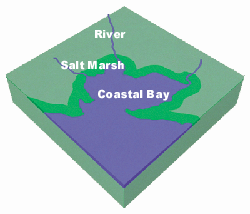 |
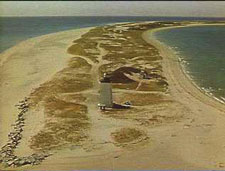 |
| lagoons drain coastal rivers | sands form a barrier along the shore |
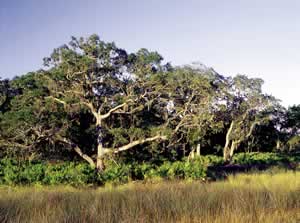 |
|
| maritime forests and adjacent marshes hold sand and mud islands in place. | |
Salt Marsh zones:
Zones are critical to knowing where to place developments on an island.
Islands are temporary formations due to wind, tides and currents. During storms they can change dramatically.
| After a hurricane this barrier island was breached as the bay waters broke across the island | Before the lagoons & embankments surged back across the island |
 |
 |
| After a hurricane the island lost its vegetative cover and the island was breached. | Before the hurricane the vegetation acted to hold drifting sand along the shore. |
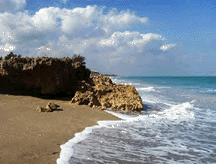 By conserving seashores we protect both the defense of the landscape and the productivity of sea waters. That is because beaches and marshlands provide feeding, nesting or nursery areas for organisms that are essential parts of the marine food web.
By conserving seashores we protect both the defense of the landscape and the productivity of sea waters. That is because beaches and marshlands provide feeding, nesting or nursery areas for organisms that are essential parts of the marine food web.
Natural features such as this rock formation along a sand beach would no more be thought of as a place to mine or quarry stone for building than would the removal of sand for constructing buildings, yet every year due to the removal of sand along the shore vast areas of the US shoreline must be replenished with sand.
Because to conserve means to keep from harm, loss, or decay, generally, there is significant confusion about what the term means when applied to coastal settlements. Since the Renaissance some --such as the Italians and the French and the Dutch have viewed the replacement of wetlands by farmland -- called reclamation-- as a legitimate form of conservation.

More lately, the Dutch among many Europeans have recognized that dunes are the first line of coastal defense against storm tides, rising sea levels and flooded rivers. With this new idea that natural vegetated areas can be beneficial to protecting the extensive investment in reclaimed or recreational lands, a form of environmental conservation distinct from the older reclamation can be seen to have emerged to replace the older version.
It is this older view of conservation as reclamation that Eugene Odum criticized as a merely agronomic approach to land management and which Aldo Leopold and Raymond Dasmann criticized as economically too narrow to encompass the real value of the ecological service provided by shifting dune systems.
The back shore includes secondary dunes.
Dunes and the accompanying vegetational and topographical features of the island anchor the otherwise shifting shore. This area of lagoons, fresh water ponds and even tidal creeks can be the real productive unit of the island from a biological perspective. That is because the now stable ground forms the foundation for grasses, shrubs, bushes and trees to grow providing shelter, food and breeding areas for ground animals and birds.
Beach
Beaches absorb the full fury of waves, surf, wind and rain or snow along the outer most shore. Built from the sedimentary residue of rivers deposited downstream in the northern estuaries, sand makes it way south to replenish the beaches that stretch from New England, New York or New Jersey to Mexico. Along these sand stretches of seashore, four kinds of marine turtles nest from May until August and hatchlings emerge from the sands from July through September. The Green Turtle, Hawksbill Turtle, Loggerhead Turtle, and the Kemp's Ridley Turtle all use southern beaches to nest during the tropic-like summer months. These long distance swimmers rise in rhythmic syncopation with the heaving of the breakers along the warm water beaches all summer long responding to an instinctual necessity to nest, lay eggs and return to the sea again. Beaches for these sea creatures are like our bedrooms; they are the cradle of generations of turtles to come. A beach holds the promise of the future and the legacy of a deeply hidden past in the interstices of its fine grained sands, shells, cobbles and bones.
Fore dune
This sand fence has been placed in front of the fore dune to trap blowing sand and retard dune loss. Where coastal erosion is serious the loss of dunes and barrier islands can mean the loss of productive fisheries and not just the loss of land and livelihoods. Henry David Thoreau, in walking the sands of Cape Cod's shore, once mused that "the beach is a vast graveyard," washed up by a restless sea.
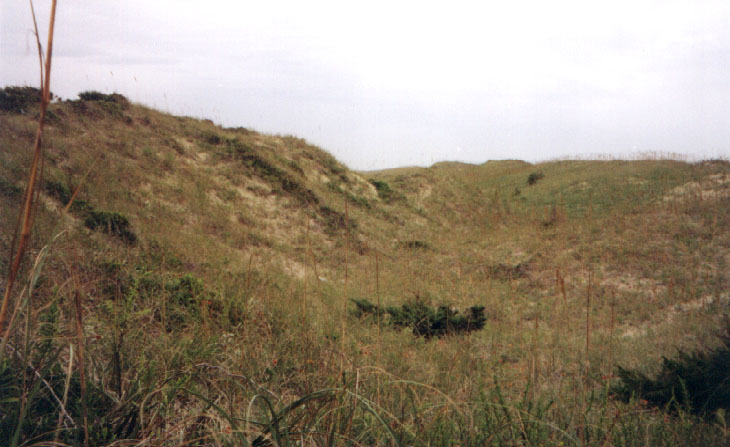
Back dune along Cape Hatteras National Seashore.
These vast vegetated areas not only catch hold the beach sands swept up by currents, winds and waves, they act as a natural groundwater recharge area. These extensive grasslands or maritime forests are called watershed. That is the rain falling into the above basin percolates deeply; into the soil and replenishes the groundwater used by island residents. Adequate watershed areas surrounding larger cities are essential to renew ground water supplies. Because groundwater supplies are replenished by rain falling on these open lands geologists refer to them as aquifer recharge areas, since groundwater is held in an underground layer of rock, rubble and sand called and aquifer.
Thus healthy dune systems have both a defensive ecological value and a watershed protection value that suggest there are more than one ecological service provided by natural features along the sandy shores. By stabilizing islands that tend to shift with storm surges, the dunes anchor the back shore areas where either marsh grasses or tropical, salt water tolerant trees thrive. In such quiet waters the bulk of our coastal fisheries are born, raised and grow to maturity. Thus the dunes anchor a productive marshland -mangrove nursery that supplies fish to subsistence, sport, or commercial fishers.
A Pearl Necklace:
Linear sands form littoral islands of the Gulf of Mexico shore off from central Florida
Boca Ciega Bay and Barrier Islands in Clearwater, FL.
Distended from the adjacent shoreline, the barrier islands with their surf swept sand beaches are a necklace of pearl white reflecting opaquely out of the pale to deep blue colors of the neighboring sea.
Barrier Isle is is as much a state of mind as a condition of being in a place. Although there are thousands of miles barrier islands strewn by glaciation and geodesy from Cape Cod to the Rio Grande and beyond, Barrier Isle is a mentality with respect to how to properly conceive what role these pearls play in fending of the rising seas. In the state of Barrier Isle you have to run ever faster just to stay in place. The smallest components of the place are indeed the most important. And the cycles of birth, growth, death and decay can be seen as a metaphor, or taken seriously as the way of the world. In a Barrier Isle frame of mind, you suddenly understand that what you develop will be taken away, what you save will save you, and what you think is worthless, may be the most valuable of all.
The removal of dunes diminishes both island protection and undermines the dune system's watershed services. When dunes are removed the self reliance of island communities becomes severely restricted. Further the removal of marshes and mangroves by fill for homes means that flood water will not be deflected into coastal wetlands that naturally absorb storm surges and excessive rainfall. Barrier Islands are the first protection line along the shore and the dune systems are the frontline of island preservation along any sandy shore.
Marsh lands behind developed barrier island.
Misunderstood for years as sources of stench, stagnation, and disease marshes along the ocean shore where reclaimed for places to live and work. This causeway across the marsh in Maryland accentuates the obstacles that these broad tidal rivers of grass posed for early settlers. The marsh, it has been shown, is the elusive center of coastal wetland productivity because of its unique blend of land and sea creatures, enormous nutrient storehouse and abundant sunlight. Under these nourishing conditions diatoms, in the water, bacteria and algae in the mud, grass along the banks and leaf litter from tidal creeks feed the creatures that we are most familiar with. Crabs, lobsters, mussels, clams and oysters must all have healthy, extensive and tidally functional marshes for these fisheries to prosper.
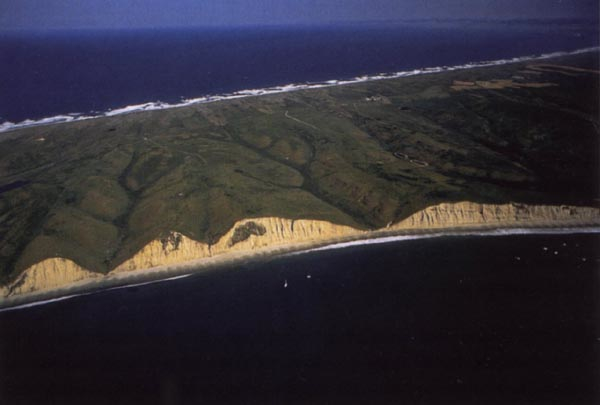
The marshes of Drake's Bay in Point Reyes in California, nourish a thriving oyster bank.
Galapagos tortoise, an endangered species, being nursed to health
Many things we take for granted, fresh air, drinking water, healthy recreation. In many ways we are like children on the seashore, unaware of the wonder, richness and deeply intricate pattern of life along the coastal bays, estuaries and lagoons of which the beaches are an essential part. Together the beach and the marshes bind the barrier island to the land and inherently make for a maritime nursery, whose produce from shrimp to shad, bass or salmon are caught, quite often far out at sea, away from the sight of land. For this reason there is a surface understanding of the shoreline's beauty that may move use to understand the sea sides more unfathomable aspects. In developing an attitude of respect for an estuarine preservation ideal, the ecologically functioning marsh is quite essentially, the crib of life containing the next generation of the seas great variety of fish and shellfish, birds and mammals.

From the East Bengal mangroves roamed by fierce tigers of the Sunderbands {shown above}, to the shrimp rich waters of the Sea Islands, these maritime forests and grasslands have not been well understood by modern industrial engineering. In East India after the great tsunami of 2004, the villages situated behind mangrove forests were afforded greater protection than those people trapped along the open beach. In an era of rising sea levels the vegetation that holds the sand and mud steady along the shore is of ever greater importance to the defense of the shore and the protection of human life.
![]()
![]()